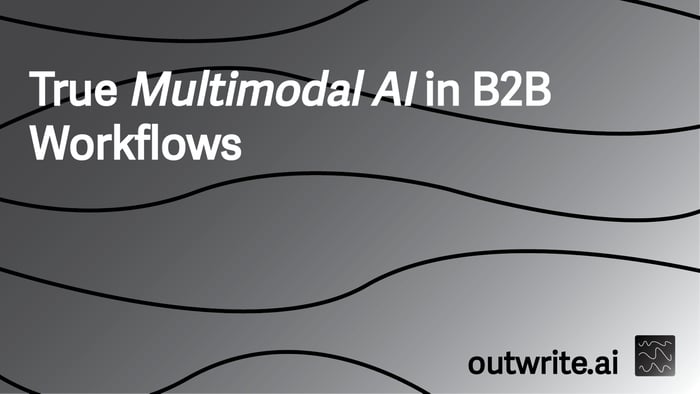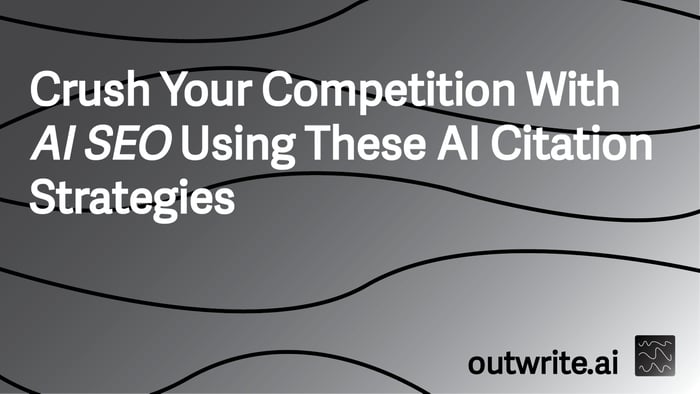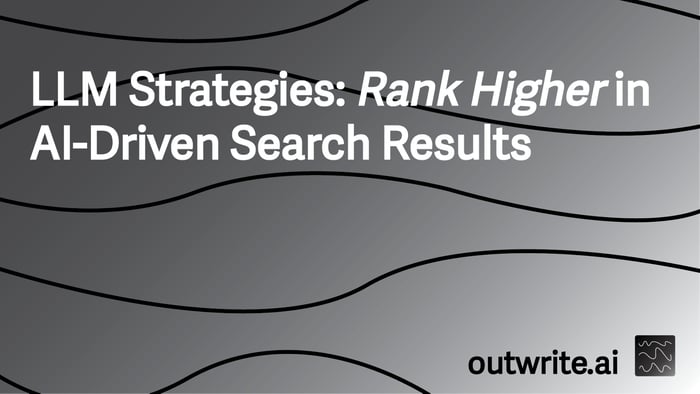Table of Contents
True multimodal AI combines and interprets various data types—text, images, audio, video—to create a unified understanding. This capability is changing how B2B companies operate, offering deeper insights and automating complex tasks. Businesses can make more informed decisions and streamline operations.
This article explores the mechanics of multimodal AI, its market trajectory, and practical applications within B2B workflows. We examine real-world examples, implementation strategies, and the significant impact on efficiency and customer relations.
Understanding Multimodal AI
Multimodal AI represents a significant leap from traditional AI systems. Instead of processing one type of data, it integrates and analyzes information from multiple modalities simultaneously. This allows for a more comprehensive understanding of complex situations, mirroring human perception.
What is Multimodal AI?
Multimodal AI refers to artificial intelligence systems that can process and understand information from more than one input modality. For example, it can analyze text, images, and audio together to derive context and meaning. This integration helps AI interpret nuances that single-modality systems miss, leading to more accurate and relevant outputs.
Why is Multimodal AI Important for B2B?
For B2B organizations, multimodal AI offers the ability to process the rich, diverse data streams common in business environments. Customer interactions often involve emails, voice calls, video meetings, and shared documents. Multimodal AI can connect these disparate pieces of information, providing a complete view of customer needs or operational challenges. This leads to better decision-making and improved service delivery.
Key Components of Multimodal AI
- Data Fusion: This involves combining data from different sources into a coherent representation. Techniques range from early fusion (combining raw data) to late fusion (combining outputs from individual models).
- Cross-Modal Learning: AI models learn relationships between different modalities. For instance, an AI might learn that certain keywords in text often appear with specific images or tones of voice.
- Representation Learning: The AI develops abstract representations that capture the essence of information across modalities. This allows it to generalize and apply knowledge to new, unseen data.
- Unified Architectures: Modern multimodal AI often uses transformer-based architectures that can handle various input types within a single model, improving efficiency and coherence.

Market Growth and B2B Potential
The multimodal AI market is experiencing rapid expansion, reflecting its growing importance across industries. This growth signals a clear opportunity for B2B companies to invest in and integrate these advanced AI capabilities into their operations.
Current Market Size and Projections
The global multimodal AI market was valued at approximately USD 1.73 billion to USD 1.83 billion in 2024, according to Precedence Research and Grand View Research. This market is projected to grow substantially, reaching between USD 10.89 billion and USD 42.38 billion by 2030 or 2034. This represents a Compound Annual Growth Rate (CAGR) of around 32.7% to 37.2%, as reported by GM Insights and Research Nester. North America, particularly the U.S., leads this growth.
Why B2B is a Prime Candidate for Multimodal AI
B2B environments generate vast amounts of diverse data, making them ideal for multimodal AI applications. From sales calls and customer support tickets to product designs and market research reports, information comes in many forms. Multimodal AI can unify this data, providing a holistic view that single-modality AI cannot achieve. This leads to more accurate forecasting, personalized customer interactions, and optimized operational processes.
Industries Benefiting from Multimodal AI
Multimodal AI is finding applications across various sectors, demonstrating its versatility and value. These industries often have complex data landscapes that benefit from integrated analysis.
- Healthcare: Combining patient records, medical images, and clinician notes for improved diagnostic accuracy and treatment outcomes, as highlighted by Grand View Research.
- Automotive: Enhancing autonomous driving systems by integrating visual data from cameras, lidar, and radar with sensor data and navigation instructions.
- BFSI (Banking, Financial Services, and Insurance): Improving fraud detection by analyzing transaction data, customer communication logs, and behavioral patterns.
- Media & Entertainment: Personalizing content recommendations by understanding user preferences across viewing history, search queries, and social media interactions.
| Year | Market Size (Low Estimate) | Market Size (High Estimate) | CAGR Range |
|---|---|---|---|
| 2024 | 1.73 | 1.83 | N/A |
| 2030/2034 | 10.89 | 42.38 | 32.7% - 37.2% |
Core Applications in B2B
Multimodal AI offers several core applications that directly address critical B2B challenges. These applications focus on improving efficiency, enhancing decision-making, and driving revenue growth by making sense of complex, varied data.
AI-Driven Lead Scoring and Prioritization
B2B sales teams often struggle to identify the most promising leads from a large pool. Multimodal AI can analyze various data points—such as website interactions, email engagement, social media activity, and even sentiment from initial calls—to score and prioritize leads automatically. This allows sales representatives to focus their efforts on high-potential accounts, streamlining workflows and increasing conversion rates, as seen in SuperAGI's insights.
Personalized Customer Engagement
Generic communication rarely resonates in the B2B space. Multimodal AI helps create highly personalized engagement strategies. It analyzes customer data across text (emails, chat logs), audio (call transcripts), and visual (web browsing behavior) modalities to understand preferences and pain points. This enables the generation of tailored content and orchestration of customer journeys, significantly boosting open and conversion rates. Forrester Research indicates that AI personalization can increase customer engagement by up to 20%.
Automated Operations and Workflow Streamlining
Many B2B operations involve repetitive, data-intensive tasks. Multimodal AI can automate these processes, from customer support to supply chain management. For instance, it can automatically tag customer inquiries, classify their priority based on text and sentiment, and integrate findings with CRM systems. This accelerates response times and improves overall operational efficiency. Our Business Ladder notes that multimodal AI enhances business operations.
Predictive Maintenance and Quality Control
In manufacturing and logistics, downtime is costly. Multimodal AI can fuse sensor data from machinery with maintenance logs, historical repair records, and even employee reports or video inspections. This integrated analysis predicts equipment failures before they occur, enabling proactive maintenance. A manufacturing company, for example, achieved a 30% reduction in downtime and significant cost savings by using multimodal AI for predictive maintenance, according to GM Insights.

Real-World Case Studies
Examining real-world implementations shows the tangible benefits of multimodal AI in B2B settings. These examples highlight how diverse data integration leads to measurable improvements in revenue, efficiency, and customer satisfaction.
SuperAGI & B2B SaaS Startup: Revenue Growth Through Personalization
A B2B SaaS startup partnered with SuperAGI to integrate AI into their CRM. This system used multimodal data for lead scoring, content personalization, and journey orchestration. By analyzing customer interactions across various channels, the AI tailored marketing messages and sales approaches. The result was a 3X revenue growth, alongside significant increases in open and click rates due to AI-driven personalized campaigns. This demonstrates the power of combining diverse customer data for targeted engagement.
Leading Retailer: Boosting Sales with Customer Behavior Analysis
A leading retailer implemented multimodal AI to analyze customer behavior from both online and in-store interactions. This involved processing website clickstreams, purchase histories, in-store video analytics, and customer feedback. The AI identified patterns and preferences that led to optimized product placements and personalized promotions. This initiative resulted in a 20% sales increase, as reported by Grand View Research. The ability to correlate diverse data points provided a complete picture of customer journeys.
E-commerce Platform: Enhanced Sales Conversions
An e-commerce platform deployed multimodal AI to analyze customer reviews, product images, and browsing behavior. The AI processed textual sentiment from reviews, identified visual cues in product images, and tracked user navigation paths. This comprehensive analysis allowed the platform to generate more accurate and appealing product recommendations. This led to a 25% increase in sales conversions, according to GM Insights. The system's ability to understand preferences across different data types was key to its success.
Forecastio: Reducing Sales Cycle Length
Forecastio, a company specializing in AI-based sales forecasting, helped B2B sales teams reduce their sales cycle length by 30%. Their AI tools integrate various sales data points, including CRM entries, communication logs, and market trends. This multimodal approach provides more accurate predictions and helps sales professionals prioritize their efforts. Another enterprise sales team using AI-powered tools saw a 40% reduction in sales cycle, further emphasizing the efficiency gains.
Strategic Implementation Guide
Implementing multimodal AI requires a structured approach. B2B companies need to assess their current infrastructure, select appropriate platforms, and focus on data quality to ensure successful deployment and maximize returns.
Steps for Successful Multimodal AI Implementation
- Assess Infrastructure and Data Sources: Begin by evaluating existing data sources and integration capabilities. Identify where textual, visual, and audio data reside and how they can be combined. This initial assessment helps pinpoint opportunities for multimodal AI deployment, as suggested by GM Insights.
- Choose Scalable AI Platforms: Select AI-integrated CRM systems or custom multimodal AI tools that can handle vast and varied data streams. Ensure compatibility with current workflows and systems to avoid disruption. Platforms that offer flexibility and scalability are crucial for long-term success, as highlighted by SuperAGI.
- Train Models with Diverse, High-Quality Data: Incorporate various data formats relevant to your workflows, such as images, text, and audio. High-quality, diverse data is fundamental for maximizing the AI’s learning and prediction capabilities. This ensures the AI can accurately interpret complex business scenarios.
- Focus on Continuous Monitoring and Improvement: Use performance metrics like sales productivity, cycle time reduction, customer satisfaction scores, and operational cost savings. Regularly refine AI models and processes based on these metrics to ensure ongoing optimization and adaptation to changing business needs.
- Address Ethical and Governance Considerations: Ensure data privacy, transparency, and compliance standards are met. This is particularly important when integrating multimodal AI in business workflows, as it often handles sensitive information. PwC emphasizes the importance of these considerations.
Best Practices for Data Integration
- Standardize Data Formats: Convert disparate data types into compatible formats for easier processing by AI models. This might involve transcribing audio, extracting text from images, or normalizing numerical data.
- Centralize Data Storage: Use a unified data lake or warehouse to store all multimodal data. This provides a single source of truth and simplifies data access for AI models.
- Implement Robust Data Governance: Establish clear policies for data collection, storage, access, and usage. This ensures data quality, security, and compliance with regulations.
- Utilize API Integrations: Connect various business systems (CRM, ERP, marketing automation) through APIs to facilitate real-time data exchange with multimodal AI platforms.

Operational Efficiency Gains
Multimodal AI significantly boosts operational efficiency in B2B workflows by automating tasks, improving resource allocation, and providing deeper insights into processes. This leads to cost reductions and faster execution across various departments.
How Multimodal AI Streamlines Operations
By integrating and analyzing diverse data, multimodal AI can identify bottlenecks, predict resource needs, and automate routine decisions. For example, in customer support, it can combine text from chat logs, audio from calls, and visual cues from screen shares to quickly diagnose issues and route them to the correct department. This reduces manual effort and speeds up resolution times.
Examples of Efficiency Improvements
- Automated Document Processing: Multimodal AI can extract and verify information from invoices, contracts, and reports, regardless of their format (scanned images, PDFs, digital text). This reduces manual data entry errors and processing time.
- Optimized Supply Chain Management: By analyzing sensor data from logistics, weather patterns, traffic reports, and supplier communications, AI can predict delivery delays and suggest alternative routes or suppliers, minimizing disruptions.
- Enhanced Fraud Detection: In financial services, AI can combine transaction data, customer communication logs, and even biometric data to detect fraudulent activities with higher accuracy than single-modality systems.
- Predictive Maintenance: As discussed, fusing sensor data with maintenance records and visual inspections allows for proactive repairs, leading to a 30% reduction in downtime for manufacturing companies, as noted by GM Insights.
Impact on Cost Reduction
The automation and optimization driven by multimodal AI directly translate into cost savings. Reduced manual labor, fewer errors, and minimized downtime contribute to a healthier bottom line. AI Agent systems incorporating multimodal data have demonstrated up to an 80% cost reduction and a 30% higher ROI in task automation scenarios, according to Multimodal.dev.
Enhancing Customer Engagement
In the B2B world, strong customer relationships are paramount. Multimodal AI provides tools to understand customers more deeply, personalize interactions, and deliver superior service, leading to increased satisfaction and loyalty.
Personalization at Scale
Multimodal AI allows B2B companies to move beyond basic personalization. By analyzing a customer's entire digital footprint—including their interactions with marketing materials, website behavior, support tickets, and even sentiment from past conversations—AI can create highly specific profiles. This enables sales and marketing teams to deliver messages, product recommendations, and solutions that are precisely aligned with individual customer needs and preferences. Forrester Research highlights that AI personalization can increase customer engagement by up to 20%.
Improved Customer Support
Customer support is a critical touchpoint. Multimodal AI can analyze the tone of a customer's voice, the content of their message, and even visual cues from video calls to understand their emotional state and the urgency of their request. This allows AI-powered chatbots or human agents to respond with greater empathy and accuracy. It also helps in routing complex issues to the most qualified support personnel. AI Agent systems have shown 90% faster support responses, according to Multimodal.dev.
Proactive Engagement and Retention
Multimodal AI can predict customer churn by identifying subtle shifts in behavior or sentiment across various interaction points. For instance, a decrease in engagement with product updates, combined with a slightly negative tone in support interactions, might signal dissatisfaction. This allows B2B companies to proactively reach out with targeted solutions or offers, improving retention rates. An e-commerce platform saw a 25% increase in sales conversions by using multimodal AI to understand customer preferences, as per GM Insights.

Data Integration and Analysis
The true power of multimodal AI in B2B workflows lies in its ability to seamlessly integrate and analyze disparate data sources. This capability transforms raw, unstructured data into actionable intelligence, driving better business outcomes.
Challenges of Unstructured Data in B2B
B2B operations generate a vast amount of unstructured data, including emails, customer call recordings, video conferences, social media posts, and images. Traditional AI often struggles to process and correlate these diverse formats effectively. This leads to data silos and missed opportunities for insight. Multimodal AI addresses this by providing a unified framework for understanding all these data types.
Methods for Data Correlation
Multimodal AI uses advanced techniques to correlate data from different modalities. These include:
- Joint Embeddings: Creating a shared vector space where data points from different modalities (e.g., an image and its textual description) are represented closely if they are semantically related.
- Attention Mechanisms: Allowing the AI model to focus on relevant parts of different modalities when making a prediction or generating an output. For instance, an AI analyzing a customer complaint might pay attention to both the specific keywords used and the tone of voice.
- Generative Models: Using models that can generate one modality from another, such as creating a textual summary from a video or generating an image from a description. This helps in understanding the underlying relationships between modalities.
Transforming Data into Business Intelligence
By integrating and correlating multimodal data, B2B companies can gain a more holistic view of their operations and customers. This leads to superior business intelligence. For example, a sales team can combine CRM data, email sentiment, and call transcripts to predict deal closure probability with higher accuracy. This comprehensive understanding helps in strategic planning, market analysis, and product development.

Future Trends and Challenges
The evolution of multimodal AI in B2B workflows is dynamic, presenting both exciting opportunities and significant hurdles. Understanding these trends and challenges is crucial for businesses planning their AI strategies.
Emerging Trends in Multimodal AI
- Increased Autonomy: Future multimodal AI systems will exhibit greater autonomy, handling complex tasks with minimal human intervention. This includes self-correcting models and AI agents that can execute multi-step processes across different modalities.
- Hyper-Personalization: The ability to process more diverse data will lead to even finer-grained personalization in B2B interactions, anticipating needs before they are explicitly stated.
- Edge AI Integration: Deploying multimodal AI models directly on edge devices will enable real-time processing and decision-making in environments with limited connectivity, such as remote industrial sites.
- Synthetic Data Generation: Multimodal AI will increasingly generate synthetic data for training, addressing data scarcity and privacy concerns, especially in sensitive B2B sectors.
Challenges in Adoption and Implementation
Despite its promise, adopting multimodal AI in B2B workflows comes with challenges:
- Data Complexity and Volume: Managing and processing the sheer volume and variety of multimodal data requires robust infrastructure and advanced data governance strategies.
- Integration with Legacy Systems: Many B2B companies operate with older, siloed systems. Integrating new multimodal AI platforms without disrupting existing operations can be complex and costly.
- Model Interpretability and Explainability: Understanding how multimodal AI models arrive at their conclusions can be difficult. This lack of transparency can be a barrier in regulated industries or where human oversight is critical.
- Talent Gap: There is a shortage of skilled professionals who can develop, deploy, and manage sophisticated multimodal AI systems. Companies need to invest in training or attract specialized talent.
- Ethical and Bias Concerns: Multimodal AI models can inherit biases from their training data, leading to unfair or inaccurate outcomes. Addressing these biases and ensuring ethical AI use is a continuous challenge.
The Road Ahead for B2B AI
The future of B2B AI is undoubtedly multimodal. Companies that proactively address the challenges and invest in the necessary infrastructure and talent will gain a significant competitive advantage. The ability to derive comprehensive insights from all forms of data will become a standard expectation, not a differentiator.
Conclusion
True multimodal AI is not just a technological advancement; it is a strategic imperative for B2B companies aiming for sustained growth and efficiency. By integrating and interpreting diverse data types, it unlocks unprecedented insights, streamlines operations, and fosters deeper customer relationships. The market's rapid expansion confirms its value.
Businesses that embrace multimodal AI, focusing on careful implementation and continuous refinement, will gain a significant competitive edge. This technology empowers organizations to navigate complex B2B environments with greater clarity and precision, driving tangible results across the board.
By Eric Buckley — Published October 24, 2025





